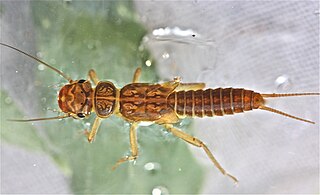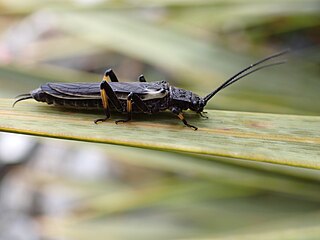
Eustheniidae is a family of insects in the order Plecoptera, the stoneflies. They are native to Australia, New Zealand, and Chile.
Ostrocerca truncata, the truncate forestfly, is a species of spring stonefly in the family Nemouridae. It is found in North America.

Pteronarcys princeps, the ebony salmonfly, is a species of giant stonefly in the family Pteronarcyidae. It is found in North America.

Isoperla similis, the black stripetail, is a species of green-winged stonefly in the family Perlodidae. It is found in North America.

Paragnetina fumosa, the smoky stone, is a species of common stonefly in the family Perlidae. It is found in North America.

Paragnetina is a genus of common stoneflies in the family Perlidae. There are at least 20 described species in Paragnetina.

Acroneuriinae is a subfamily of common stoneflies in the family Perlidae. There are about 32 genera and about 520 described species in Acroneuriinae.
Ostrocerca is a genus of spring stoneflies in the family Nemouridae. There are about six described species in Ostrocerca.

Perlodini is a tribe of Palaearctic and Nearctic stoneflies in the family Perlodidae. There are more than 80 described species in Perlodini.

Diploperlini is a tribe of springflies in the family Perlodidae. There are about 13 genera and more than 30 described species in Diploperlini.

Arcynopterygini is a tribe of springflies in the family Perlodidae. There are about 11 genera and more than 30 described species in Arcynopterygini.

Eccoptura is a genus of common stoneflies in the family Perlidae. There is at least one described species in Eccoptura, E. xanthenes. It is known as the "yellow stone" and is found in North America.

Diamphipnoidae is a family of stoneflies in the order Plecoptera. There are at least two genera and about nine described species in Diamphipnoidae.

Gripopterygidae is a family of stoneflies in the order Plecoptera. There are more than 50 genera and 320 described species in Gripopterygidae.
Notonemouridae is a family of stoneflies in the order Plecoptera. There are more than 20 genera and at least 120 described species in Notonemouridae.
Styloperlidae is a family of stoneflies in the order Plecoptera. There are at least 2 genera and 9 described species in Styloperlidae. The species etymology is based on the type locality near Sapa.

Zelandoperla maungatuaensis, commonly known as the Maungatua stonefly, is a species of flightless stonefly so far known only from a single mountainside in Otago, New Zealand.
Zelandoperla is a genus of ‘long-tailed’ stoneflies endemic to New Zealand, placed within Southern Hemisphere family Gripopterygidae.

Zelandoperla fenestrata is a widespread endemic New Zealand ‘long-tailed’ stonefly that is often abundant in high-gradient stony streams, from near sea-level up to alpine elevations. The species name 'fenestrata' refers to the window-like rectangular patterning visible on the wings of non-melanic adult specimens.

Austroperla cyrene, the black stonefly, is a species of austroperlid stonefly endemic to New Zealand. It is the single species in the genus Austroperla. The species is a 'shredder' that lives and feeds on decomposing wood and leaves in streams throughout New Zealand. It is particularly common in forested streams but relatively rare or absent from deforested streams.















